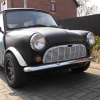My first attempt at making the stub drive shafts wasn't good enough, so I bought a small lathe and made up some new ones. Also made a chainguard.
 P1030208.jpg 72.65K
56 downloads
P1030208.jpg 72.65K
56 downloads P1030210.jpg 67.05K
65 downloads
P1030210.jpg 67.05K
65 downloads P1030211.jpg 70.2K
56 downloads
P1030211.jpg 70.2K
56 downloadsI've buit the first couple of battery modules. They're made up of 10 amp-hour 3 volt lithium cells. Each module is 24 volts and 50 amp hours and weighs about 16 kilos. I plan to use three of them to start with, for a pack voltage of 72V, and will add another two later when I upgrade the controller.
Fitted a proximity sensor to each motor. These are hooked up to rpm switches to limit the max rpm and prevent the commutator spinning itself apart.
 P1030214.jpg 83.42K
72 downloads
P1030214.jpg 83.42K
72 downloads P1030237.jpg 59.21K
38 downloads
P1030237.jpg 59.21K
38 downloads P1030244.jpg 68.64K
26 downloads
P1030244.jpg 68.64K
26 downloadsI made another chainguard for the top half of the subframe. It's not oil tight, as I just plan to grease the chains, but it should keep out most of the road muck. The two blocks behind the motors are the reversing contactors (heavy-duty relays), one for each motor. Forward/reverse will be selected using an old auto selector I found at an auto jumble. I just had to reposition the switches and add the F/R lettering.
The motors will be air-cooled. Spot the repurposed mini vents :)
 P1030248.jpg 72.11K
119 downloads
P1030248.jpg 72.11K
119 downloads P1030240.jpg 32.15K
64 downloads
P1030240.jpg 32.15K
64 downloadsI'm going to use a 72V 450A Alltrax controller just to test things out and get my MOT and will upgrade to a more powerful controller when funds allow. Made a simple frame to support the controller and the blower for cooling the motors. The thing just to the right of the blower is a throttle body from an MG, complete with throttle position sensor. The controller takes its throttle signal directly from this.
 P1030245.jpg 77.7K
183 downloads
P1030245.jpg 77.7K
183 downloads P1030247.jpg 77.38K
112 downloads
P1030247.jpg 77.38K
112 downloadsStill a lot of small jobs to do, but I'm really getting excited about refitting the subframe. Will try to update more often from now on.
Cheers, Malcolm



















